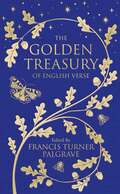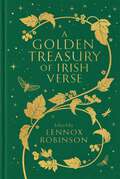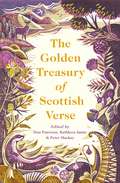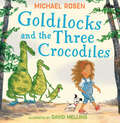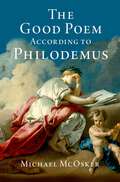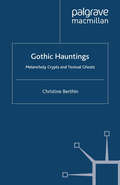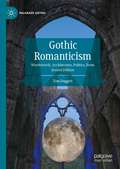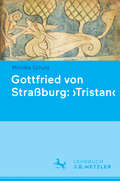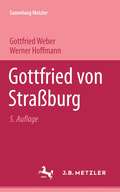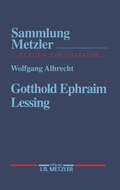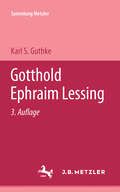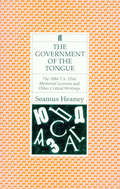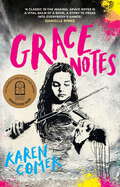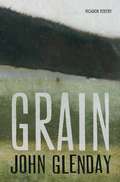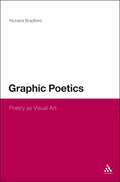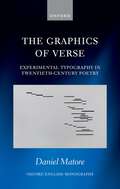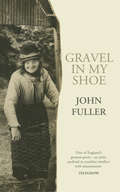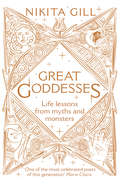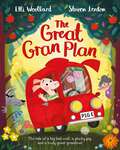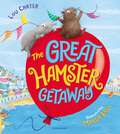- Table View
- List View
The Golden Treasury: Of English Verse (Macmillan Collector's Library #168)
by Francis Turner PalgraveThe Golden Treasury is one of the most loved anthologies of English poetry ever published. The book was meticulously compiled by poet and scholar Francis Turner Palgrave, in collaboration with Alfred Tennyson, who was then poet laureate.It is arranged chronologically in four books which each celebrate a different era in the evolution of English poetry, from Elizabethan to the 19th century. All the greats are here, including Shakespeare and Milton, Marvell and Pope, Wordsworth and Keats. First published in 1861, it became the standard anthology for over 100 years.This Macmillan Collector’s Library edition includes a foreword by Poet Laureate Carol Ann Duffy, and is published to mark Macmillan’s 175th anniversary.
A Golden Treasury of Irish Verse
by Lennox RobinsonOriginally published in 1925, A Golden Treasury of Irish Verse is an impressive and beautifully crafted collection of the best of Irish poetry from ancient times to the early twentieth century. It features folklore and legend, often beautifully translated from Gaelic with contributions from William Congreve, Thomas Moore, Moira O’Neill, Katharine Tynan, Padraic Colum and many more.This edition was created by Irish poet and dramatist Lennox Robinson whose main criteria for selection was that each poem should be excellent. He acknowledges the help of both W. B. Yeats and A. E. Housman in choosing the poems and poets.Capturing wide-ranging themes of love and loss, home and country, freedom and conflict, this beautifully produced collection of uplifting verse makes the perfect gift for poetry lovers everywhere.
The Golden Treasury of Scottish Verse
by Kathleen Jamie, Don Paterson and Peter MackayThe Golden Treasury of Scottish Verse is a timeless collection of Scottish poetry. It contains over three hundred poems ranging from the early medieval period to the twenty-first century, and paints a full-colour portrait of Scotland’s poetic heritage and culture. Edited and introduced by award-winning poets Kathleen Jamie, Don Paterson and Peter Mackay, and including poems by Robert Burns, Carol Ann Duffy, Sorley Maclean, Violet Jacob, William Dunbar, Meg Bateman, George Mackay Brown, Màiri Mhòr nan Òran, Robert Louis Stevenson, Jackie Kay, Liz Lochhead, and many more, The Golden Treasury of Scottish Verse is a joyous celebration of Scotland’s literary past, present and future.
Goldilocks and the Three Crocodiles
by Michael RosenA fabulously funny take on a classic story from two giants of children’s books!
The Good Poem According to Philodemus
by Michael McOskerThis book elucidates the poetics of Philodemus of Gadara, a first century BCE Epicurean philosopher and poet, whose On Poems survives in extensive fragments among the Herculaneum papyri. Although his treatise was primarily polemical and lacks positive exposition, his views are often recoverable from a careful reading of the debates, occasional direct evidence, and attention to his basic Epicurean commitments. His main critical principle is that form and content are inseparable and mutually-reinforcing: a change in one means a change in the other. The poet uses this marriage of form and content to create the psychological effect of the poem in the audience. This effect is hard to pin down exactly. Poems produce "additional thoughts" in the audience, and these entertain them. It seems clear that Philodemus expected good poets to arrange form and content suggestively, so that the poems could exert a lasting pull on the minds of the audience. Additionally, this book summarizes the views of Philodemus' opponents, the technical terminology of literary criticism in the Hellenistic period, and the history of Epicureanism's engagement with poetics. Epicurus did not write an On Poems but Metrodorus did, and this is probably Philodemus' touchstone for his own views. Zeno of Sidon, Demetrius Laco, Siro, and other Epicureans are examined as well. The book concludes with an appendix of topics examined by Philodemus, such as genre, mimesis, "appropriateness," utility, and various technical terms.
The Good Poem According to Philodemus
by Michael McOskerThis book elucidates the poetics of Philodemus of Gadara, a first century BCE Epicurean philosopher and poet, whose On Poems survives in extensive fragments among the Herculaneum papyri. Although his treatise was primarily polemical and lacks positive exposition, his views are often recoverable from a careful reading of the debates, occasional direct evidence, and attention to his basic Epicurean commitments. His main critical principle is that form and content are inseparable and mutually-reinforcing: a change in one means a change in the other. The poet uses this marriage of form and content to create the psychological effect of the poem in the audience. This effect is hard to pin down exactly. Poems produce "additional thoughts" in the audience, and these entertain them. It seems clear that Philodemus expected good poets to arrange form and content suggestively, so that the poems could exert a lasting pull on the minds of the audience. Additionally, this book summarizes the views of Philodemus' opponents, the technical terminology of literary criticism in the Hellenistic period, and the history of Epicureanism's engagement with poetics. Epicurus did not write an On Poems but Metrodorus did, and this is probably Philodemus' touchstone for his own views. Zeno of Sidon, Demetrius Laco, Siro, and other Epicureans are examined as well. The book concludes with an appendix of topics examined by Philodemus, such as genre, mimesis, "appropriateness," utility, and various technical terms.
Got Him (Read Write Inc Series (PDF))
by Gill Munton Tim Archbold Ruth MiskinThe Red Ditty Books offer children practice in reading short decodable passages that form an important bridge between reading single words and whole sentences. They reinforce the Read Write Inc. Phonics Set 1 sounds. Each book contains three fun and humorous ditties with linked reading activities to develop accuracy, fluency and comprehension. They also prepare children for reading the longer Storybooks and Non-fiction books. Activities at the start of the books help children to practise the sounds and words they will encounter in the book. Questions to talk about at the end of the story provide an extra opportunity for developing childrens comprehension. The books are part of the Read Write Inc. Phonics programme, developed by Ruth Miskin. The programme is designed to create fluent readers, confident speakers and willing writers. It includes Handbooks, Sounds Cards, Word Cards, Storybooks, Non-fiction, Writing books and an Online resource. Read Write Inc. is fully supported by comprehensive professional development from Ruth Miskin Training.
Gothic Hauntings: Melancholy Crypts and Textual Ghosts
by Christine BerthinWhat is buried in the crypts of the Gothic? Building on psychoanalytic research on haunting, cryptonymy and melancholy, as well as on French philosophies of language, this book explores how haunting is not just a Gothic narrative device but the symptom of an impossibility of representation and of an irreparable loss at the heart of language.
Gothic Romanticism: Wordsworth, Architecture, Politics, Form (Palgrave Gothic)
by Tom DuggettGothic Romanticism: Wordsworth, Architecture, Politics, Form offers a revisionist account of both Wordsworth and the politics of antiquarianism in the late eighteenth and early nineteenth centuries. As a historically-driven study that develops a significant critique and revision of genre- and theory-based approaches to the Gothic, it covers many key works by Wordsworth and his fellow “Lake Poets” Samuel Taylor Coleridge and Robert Southey. The second edition incorporates new materials that develop the argument in new directions opened up by changes in the field over the last decade. The book also provides a sustained reflection upon Romantic conservatism, including the political thought and lasting influence of Edmund Burke. New material places the book in wider and longer context of the political and historical forms seen developing in Wordsworth, and proposes Gothic Romanticism as the alternative line of cultural development to Victorian Medievalism.
Gottfried von Straßburg: 'Tristan'
by Monika SchulzGottfried von Straßburg ist neben Hartmann von Aue und Wolfram von Eschenbach der meistgelesene Autor im Studium der Älteren deutschen Literatur und sein 'Tristan' ist einer der vielschichtigsten Texte dieser Zeit. Dieser Band bietet eine übersichtlich strukturierte Gesamtdarstellung des 'Tristan', er erläutert seine zentralen Themen und Motive ausführlich und verweist jeweils auf wichtige Forschungsfragen. Bei der Analyse werden zudem Vergleiche mit den Vorläuferversionen von Berol, Eilhart von Oberg und Thomas von Bretagne geboten. Ein Schlusskapitel behandelt weiterführende Aspekte wie etwa Passion und Gender und die Rezeption bei den Fortsetzern Gottfrieds.
Gottfried von Strassburg (Sammlung Metzler)
by Gottfried Weber Werner HoffmannDichter ohne Spuren? Über Gottfried von Straßburg ist kaum Biografisches überliefert, nur dürftige Fakten zu seinem Werk sind gesichert. Gottfried Weber und Werner Hoffmann referieren aufgrund der kontroversen Deutung die unterschiedlichen Forschungspositionen und kennzeichnen die strittigen Probleme.
Gotthold Ephraim Lessing (Sammlung Metzler)
by Wolfgang AlbrechtLessing als Schlüsselfigur der Aufklärung. Vor dem Hintergrund Lessings Werdegangs stellt der Autor die Werke des Dichters in Einzelanlysen vor. Es entsteht ein geschlossenes Bild Lessings Gesamtwerks, das auch das historische Umfeld einbezieht. So werden die zentralen Strömungen sowohl der Epoche als auch in Lessings Denken und Schaffen sichtbar. Eine gelungene Einführung für Schule und Hochschule.
Government of the Tongue: Selected Prose, 1978-1987
by Seamus HeaneyThe title, The Government of the Tongue, carries suggestions of both monastic discipline and untrammelled romanticism, and is meant to raise an old question about the rights and status of poetic utterance itself. Should it be governed? Should it be the governor?Seamus Heaney here scrutinizes the work of several poets, British and Irish, American and European, whose work is responsive to such strains and tensions.
Grace Notes
by Karen ComerThis song has a grace note,a tiny note that's there for embellishmentbut can easily be ignored,not played.Tonight, I add it in -just because.We can all do with an extra noteof grace.Grace Dalfinch is a talented violinist who longs to play contemporary music in bars, but her mum forbids her. James Crux is an aspiring street artist who promised his dad he wouldn't paint in public until he's finished school. When Crux witnesses Grace's impromptu performance on a deserted tram, he's inspired to paint her and her violin; and when Grace stumbles across her portrait in a Melbourne alley by an anonymous street artist, she sets out to find its creator.Grace Notes is a debut YA verse novel, set in one of the most locked-down cities in the world - Melbourne, 2020. For fans of Cath Crowley and Pip Harry.'A classic in the making; Grace Notes is a vital balm of a book, a story to press into everybody's hands.'DANIELLE BINKS'Poetry, music and art, woven together in an uplifting story about endless lockdowns and first love.'NOVA WEETMAN'Comer captures the beats of Melbourne's 2020 and the unique experience of a generation of teens in one of the most locked-down cities in the world.'Books+Publishing'Heart and soul triumph over Covid lockdowns and restrictions . . . Karen has used the verse novel to beguile, dance and demand layers of emotion and depth that only poetry can sustain. A masterful debut!'LORRAINE MARWOOD'Like the grace note of the title, this beautiful story strikes the perfect tone, mixing colour, light and music at a time when we needed it most.'NICOLE HAYES
Grain
by John GlendayThough John Glenday has long been admired for his lyrically delicate and emotionally powerful poetry, he has remained something of a well-kept secret. His third collection, Grain, makes his singular talent available to a wider audience. Sometimes Glenday’s poems are forcefully direct; sometimes they are so quiet they feel as if they were composed within a capacious listening, as a form of secular prayer. Glenday’s seamless lyric can also disguise some wild and surreal tales: the Beauty and the Beast told in reverse, a bizarre list of new saints, or a can of peaches waiting for the invention of the tin-opener. However, the lasting impression is of a genuinely spiritual poet, one with the ability to turn every earthly detail towards the same clear light. Grain announces Glenday as an essential voice in contemporary poetry.
Graphic Poetics: Poetry as Visual Art
by Richard BradfordConcrete', 'pattern' or 'shaped' poems are well documented as experimental curiosities. While giving some attention to this sub-genre the book shifts the focus to the ways in which visual form manifests itself in 'traditional' verse, examining poems by Milton, Wordsworth, Eliot, Olson, T.E. Hulme, Auden, Williams, Larkin and Charles Tomlinson. It examines how the tactile presence of the poem on the page transcends the routine distinctions between genre and historical context, emerging as a significant but largely unexamined contribution to modernist poetics. The interpretative methodology is radical, adapting Wollheim's 'twofold thesis' - grounded in the aesthetics of visual art - to the author's own concept of the 'double pattern'.Graphic Poetics challenges the accepted protocols of reading and interpreting verse and considers how poetry is involved in a dialogue with such theoreticians as Derrida. Introducing a new perspective on how poems work and on how they generate effects, it shows how poets use devices previously unrecognised and unacknowledged, techniques which are more commonly associated with visual arts than with literature.
The Graphics of Verse: Experimental Typography in Twentieth-Century Poetry (Oxford English Monographs)
by Daniel MatoreIs poetry a visual art? Why do the pages of nineteenth-century poetry look so different to those of twentieth-century verse? Exploiting the expressive possibilities of print—from spacing and indentation to alignment and typeface—is one of the defining ways in which poetry was modernized in the twentieth century. While the visual experiments of European poets have been well documented, the typographical explorations of poets writing in English have been largely neglected. This volume confronts a major unanswered question: why did British and American poets, from the beginning of the twentieth century right up to the present day, choose to experiment with the design and lay-out of the printed page? This book aims to provide the first detailed account of this lineage of literary style, examining the poetry and criticism of figures such as Ezra Pound, Hope Mirrlees, William Carlos Williams, E.E. Cummings, Marianne Moore, David Jones, Denise Levertov, Charles Olson, Frances Motz Boldereff, and J.H. Prynne. It draws on unpublished archival materials to show how poets began to draft, sketch, and compose in new and eccentric ways as they annexed the roles of book designer and printer. Typography, it argues, was instrumental in debates about metre, free verse, and the nature of poetry as poems morphed into scores, slogans, maps, and signs. It investigates how the typography of poetry was animated by musicology, psychophysics, linguistics, politics, ophthalmology, cartography, and advertising.
The Graphics of Verse: Experimental Typography in Twentieth-Century Poetry (Oxford English Monographs)
by Daniel MatoreIs poetry a visual art? Why do the pages of nineteenth-century poetry look so different to those of twentieth-century verse? Exploiting the expressive possibilities of print—from spacing and indentation to alignment and typeface—is one of the defining ways in which poetry was modernized in the twentieth century. While the visual experiments of European poets have been well documented, the typographical explorations of poets writing in English have been largely neglected. This volume confronts a major unanswered question: why did British and American poets, from the beginning of the twentieth century right up to the present day, choose to experiment with the design and lay-out of the printed page? This book aims to provide the first detailed account of this lineage of literary style, examining the poetry and criticism of figures such as Ezra Pound, Hope Mirrlees, William Carlos Williams, E.E. Cummings, Marianne Moore, David Jones, Denise Levertov, Charles Olson, Frances Motz Boldereff, and J.H. Prynne. It draws on unpublished archival materials to show how poets began to draft, sketch, and compose in new and eccentric ways as they annexed the roles of book designer and printer. Typography, it argues, was instrumental in debates about metre, free verse, and the nature of poetry as poems morphed into scores, slogans, maps, and signs. It investigates how the typography of poetry was animated by musicology, psychophysics, linguistics, politics, ophthalmology, cartography, and advertising.
Gravel in my Shoe
by John Fuller'The only peace: to know my placeAnd what I now must do,Striding with the light full in my face,And gravel in my shoe.'Bright, elemental and as dexterously brilliant as ever, John Fuller's latest collection takes as its subject 'our ends and our origins'. Here are songs, serenades, literary cameos, an ode to a golden anniversary, a long letter to an old friend, and two majestic sequences: one dedicated to the Welsh woman of the woods, Mary Price; the other, sun-drenched sonnets that keenly observe the natural world against 'the flavour of our own mortality'. With wit, warmth and wisdom, Gravel in My Shoe playfully balances the light and shade of life, in full awareness of its passing but with a spring in its step nevertheless. It shows us, ultimately, that 'life is too short, but poetry's eternal'.
Great Goddesses: Life lessons from myths and monsters
by Nikita GillEmpowering life lessons from myths and monsters. Wonder at Medusa's potent venom, Circe's fierce sorcery and Athena rising up over Olympus, as Nikita Gill majestically explores the untold stories of the life bringers, warriors, creators, survivors and destroyers that shook the world - the great Greek Goddesses. Vividly re-imagined and beautifully illustrated, step into an ancient world transformed by modern feminist magic. 'I watch Girl become Goddessand the metamorphosis is moremagnificent than anythingI have ever known.'
The Great Gran Plan
by Elli WoollardThe pig lives in a house in the middle of the wild wood.But inside the wild wood there's a bad wolf - and this hungry wolf wants a little pig for dinner! But a house made of bricks is hard to blow down, so instead of gobbling Pig, Wolf moves to plan B: gobbling Red Riding Hood's poor defenceless grandma! But his despicable plan is soon uncovered and Pig decides to rescue Gran! Will this plucky pig make it in time? A fabulously funny twist on two classic fairy tales: Little Red Riding Hood and The Three Little Pigs. The Great Gran Plan is the first book by an exciting picture book pairing: the uniquely talented author and poet, Elli Woollard and best-selling illustrator, Steven Lenton.
The Great Hamster Getaway
by Lou CarterRaffleton Grey is as BORED as a hamster can be. He wants to go to the fair – but he's STUCK in his cage.There's only one thing for it . . . Get ready for the most exciting HAMSTER GETAWAY in history!Freedom means new friendships and tasty ice cream and fairground rides. But as night falls, things begin to get a bit scary. Perhaps home isn't so bad after all – especially if you have a new friend by your side . . .This hilarious rhyming adventure is perfect for reading (and laughing!) out loud – a fun-packed summertime getaway that's irresistible to readers both big and small!

